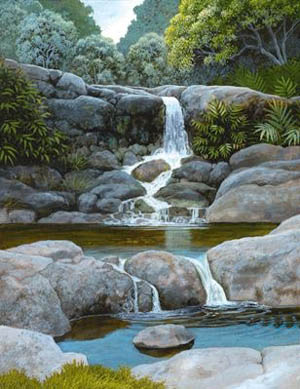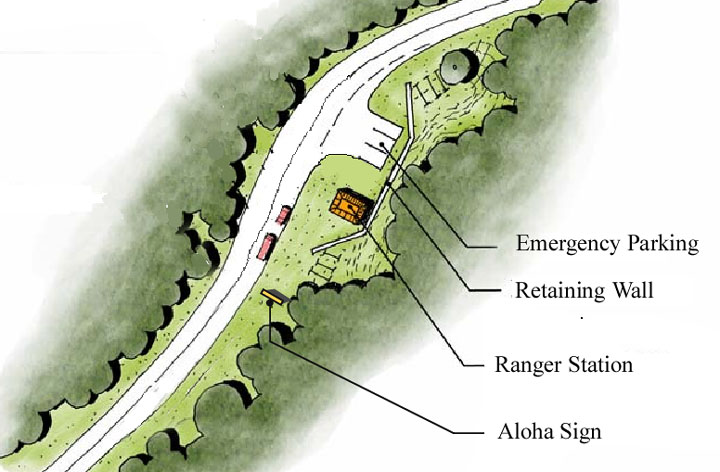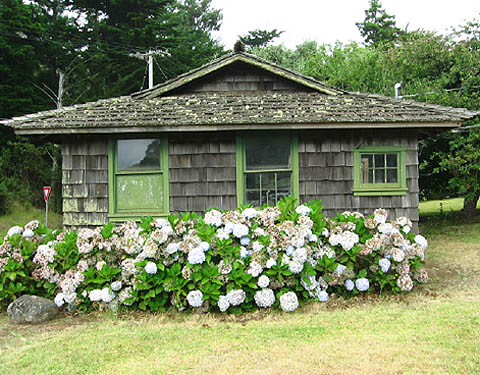SUBJECT: KOKEE MASTER PLAN
SOURCE: FRANK O. HAY fhay@aloha.net
POSTED: 12 September 2005 - 10:00pm HST

"Kokee Waters" by artist Curtis Wilson Cost
Good
News from the Board Meeting on Friday! On Friday,
September 9, 2005, the Board of Land and Natural Resources in
its meeting in Honolulu voted to: |
SUBJECT: KOKEE MASTER PLAN
SOURCE: FRANK O. HAY fhay@aloha.net
Koke'e Action Alert! Land Board Submittal
7 September 2005 - 9:00pm
Koke’e
Action Alert (Editor's Note: Out of 114 cabins, 47 are in the "Historic" Designation and will be directly negotiated with leaseholders at market value, and the cabins available in the lottery will also be leased at market value. This "market value" may make it impossible for many families to keep their cabins at Kokee, and may prohibit most Kauaians from the possibility of leasing them through the lottery.) |
SUBJECT: KOKEE MASTER PLAN
SOURCE: JUAN WILSON juanwilson@mac.com
POSTED: 29 August 2005 - 8:00am HST
DLNR Chair ignores Kauai residents wishes

modified plan (without gate) provided by Juan WIlson include in BLNR approved amendment on Kokee Draft Master Plan
by Juan Wilson 29 August 2005 Peter Young is the Lingle appointed chair of the Department of Land & Natural Resources. In an interview with The Garden Island News Young reported that "the DLNR leaders plan to put an entry gate on Koke‘e Road, and are looking to charge entry fees only to non-residents" (see article reproduced below) This is not what the Board of the DLNR voted on in January after public pressure from Kauai residents indicated their dissatisfaction with the original gated plan. Could Young mean what he said? According to Ron Agor, architect and Kauai DLNR Board representative, this was a mis-statement. Peter Young made a similar statement last week and Ron said he corrected Peter on the issue. According to Ron, the DLNR plans to collect a fee from non-residents without a physical gate. As far as I can see, how this might be accomplished without a gate may be no better than having a gate in the first place. In any case, the DLNR scheme to raise money flies in the face of the overwhelming revulsion of a gate and fee felt by the residents of Kauai. In petitions and public meetings the vast majority of island residents testified that a gate and fee charged to visit Kokee was a terrible idea. There was enough pressure on the Board of the DLNR that they included an amendment to their approval of the Kokee Draft Master Plan that eliminated the gate plan (see diagram above). If the approval of the Draft Master Plan by the Board includes a gate and fee it means that the DLNR only pretended to listen to the people who attended all those public meetings. Representatives of the DLNR will tell you that these design considerations are coming from the planning consultant, R.M. Towill Corporation. This is not the case. In personal conversations with members of Towill Corporation it was clear to me that the planning consultants were either neutral to or against the inclusion of the Kokee Road gate. It appears that Peter Young is pushing the issue personally. The DLNR has shown itself to be a rogue government department acting as an agent of corporations, the military and its own private monetary interest. It is certainly not fulfilling its mission as a protector of the public trust - "malama ka aina". After the high handed manner the DLNR has conducted the 5000 acre land grab by the PMRF on the Mana Plain and the development of the Kokee Master Plan we can only doubt the trustworthiness of Peter Young and his crew.
|
| Juan
Wilson alternative to DLNR Draft Master Plan At the BLNR hearings in January, Juan Wilson submitted an alternative scheme for the entry and lodge areas of the Kokee State Park Draft Master Plan that was presented in Eleele to Kauai residents in November of 2004. At the January 14th 2005 hearing, those alternatives (in the form of drawings replacing Figures 7-2 and 7-4 of the DMP) were included in an amendment to the motion to approve the Draft Master Plan. In addition, the wording of the amendment, as formulated by board member Ron Agor, included a verbal description of the alternative scheme. The alternative scheme included four major elements. 1) The removal of a gate and security booth at the entrance of the park to be replaced by a Ranger Station and “Welcome to the Kokee State Park” sign. 2) The construction of a “Grand Lodge” that would provide overnight accommodations for 16 beds (expandable to 32) at the edge of Kanaloahuluhulu Meadow to be connected to the refurbished Museum. 3) The restriction of “visitor” traffic beyond the “Lodge” area. This would include a realignment of Kokee Road so that the “Lodge” area is the natural terminus of the trip up from Waimea Canyon. To accommodate visitors to the Kalalau Lookouts and trailheads the state (or a vendor) would operate electric jitneys as shuttles from the “Lodge” to sites beyond. 4) The preservation of the residential community in Kokee as the “Eyes of the Island” and friends of the upland forest. An overview of the scheme is to transform the experience of riding up the canyon road and arriving at Kokee. It makes the Kokee “Lodge” area the real terminus of the trip. It makes the trails and lookouts beyond the “Lodge” and extra special event for the visitor. Something only experienced by hiking, biking or taking a guided tour. It does not provide “drive-up” access for rental cars to the trailheads or Kalalau lookouts. Elements of the scheme include: A) Make the visitor feel welcome to experience the drama of Waimea Canyon without fees or restrictions. B) Create an exciting and informative place of arrival for visitors to Kokee. Provide eating, sleeping, recreational and educational opportunities at this “end of the road”. C) Operate a “Grand Lodge” with sleeping, banquet and meeting accommodations that fill be the architectural focus and terminus of the “road to Kokee”. This will be an income generating activity for the Park and offset the impact on the current residential community on visitor accommodation needs as seen by the Parks Department. D) For visitors wishing to go beyond the “Lodge” area provide a “Station” as the starting point for hikers, bicyclists, or shuttle riders. This will be an income generating activity for the Park. A crucial aspect of this scheme is the nature of the restrictions to private vehicular traffic that might be imposed. In my original “Lodge” area scheme I realigned the road leading beyond the “Lodge” area so that it formed a “tee” intersection with Kokee Road. I identified a sign at the intersection reading “Staff & Residents Only”. The idea was to eliminate tourist rental cars traveling beyond the “Lodge” area to Kalalau lookouts or upland trailheads. I intentionally did not specify the definition of “Resident”. In my mind it might have meant anything from Kokee resident, Kauai County resident to State of Hawaii resident. That definition could be adjusted based on traffic, beginning with the least restrictive mode. The intent was to restrict traffic on the road beyond the “Lodge” so that it would be safe for slow electrical jitneys, bicycles and and hikers as well as the limited number of “residents”. Obviously, the people living on the island want as few restrictions as possible to their movement. Their wishes and uses of Kokee need to be included to any balanced approach. I personally feel vehicular restrictions can be used positively in environmentally delicate areas without violating the rights or interests of the public. For example, on Nantucket Island to drive on the beach it is required that you are a resident of the island and have a beach access permit sticker on your four-wheel drive vehicle. Violators are heavily fined. Since January I have modified some details of the transportation elements of “Lodge” area plan. This includes separation of bus parking, car parking, jitney/bike routes, and pedestrian circulation. Enclosed with this letter is a copy of the “Entry” area plan submitted in January and an updated version of the “Lodge” area plan. Note that if my scheme were implemented that the Kalalau lookouts parking lot expansion plans may not be necessary. Efforts at the lookouts instead would involve providing what would be needed for the shuttle from the “Lodge”. |
TGI - Young: Visitors may pay to tour Kokee by Lester
Chang on 28 August 2005 in the Garden
Island News |
|
More
Information If you have questions, or need additional information try the contact below: from the state hired
planning consultant - To reach DLNR staff
on this issue - |
Pau
